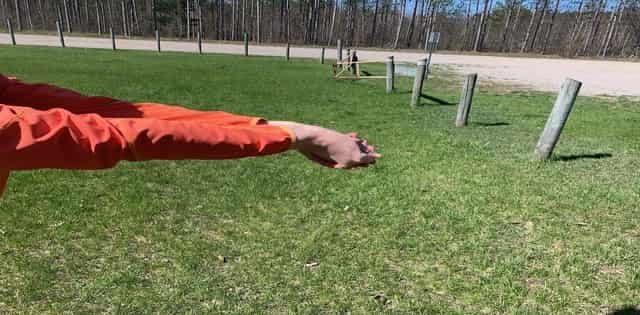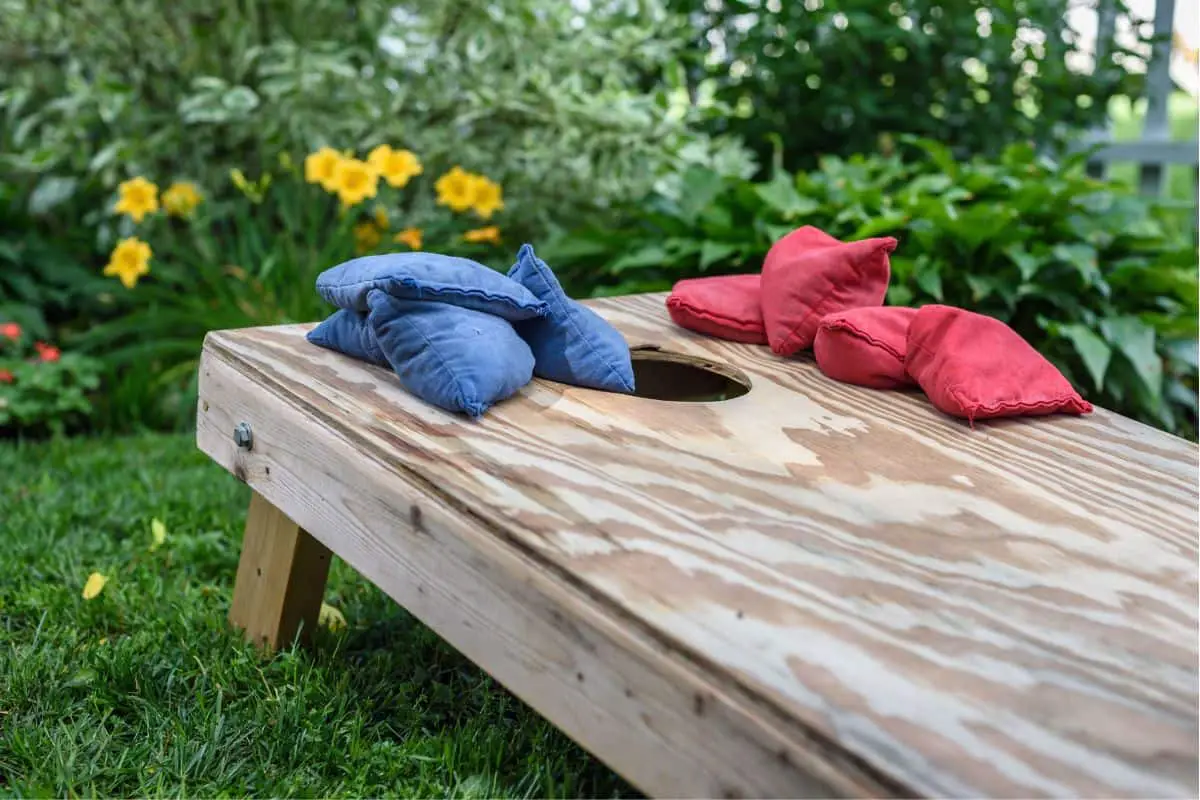Bumping the ball is one of the most important skills that you can possess in volleyball. This is how you will pass the ball to your teammate. Because of how basic this skill is, it’s often expected that every member on the team will be able to do it effectively.
The good news is that performing the bump correctly doesn’t have to be difficult. But it will rely on you understanding a few fundamentals. Keep reading to learn the secrets to bumping a ball.

1. Form a Platform With Your Forearms
The first most fundamental part of a good pass actually starts with your hand. By positioning your hands properly, you will form a strong platform with your forearms. To do this, you will need to place your hands both palms up, and lay one on top of the other. Now, bring your thumbs together so that they’re beside each other and in the middle of your hands. Keep your thumbs level.
The aim of this is to be able to form a flat platform with your forearms. You want the ball to land on your forearms. You don’t want the ball to land on your wrists. This is a common mistake that a lot of beginner players make. Because of this, they might develop wrist pain after the game. As long as you have a strong platform, you will find it easier to control the ball.
This is such an important skill to master. It’s a good idea to practice positioning your hands and forearms even when you’re off the court – you don’t need a ball or a partner to do this! When you’re playing in a fast-paced game or practice, this movement into forming a platform should happen quickly and naturally. So practice it lots!
2. Aim With Your Shoulders
Another common mistake that players make is trying to aim with their forearms. While this feels like a natural response, it will be inaccurate. The best response is to aim with your shoulders. The reason why you do this is to ensure that you are maintaining the flat platform that you have created. Both of your forearms will be turning at the same angle.

3. Push With Your Knees
The next thing to consider is how you are going to put maximum power behind the pass. You don’t want to be pushing with your forearms. This can compromise the accuracy of the shot. The best solution is by making sure that you are pushing with your knees. To do this, you will need to use the right passing stance. Here’s what that should look like:
- Place your legs shoulder-width apart, and one foot slightly in front of the other (like you’re taking a step)
- Bend at the knees
- Keep your hands straight
- You should be leaning forward, so your forearms are at an angle
- Place the weight onto your back foot, transitioning to the front foot as you pass.
Interestingly, deciding which foot is in front of the other doesn’t matter if you’re left or right-handed. This is one of those techniques that you’ll end up doing on the move, so make sure you practice with each foot forward.
As we mentioned, you can aim with your shoulders. But it’s a lot easier if you angle your body so you are facing in the direction you want the ball to go.
4. Shuffling Sideways to Get to the Ball
The next thing you need to do is make sure that you are underneath the ball when it lands. How you do this will depend on how much of the court you need to cover. If it is only a short distance, you might be able to shuffle sideways. This is a good way of making sure that you don’t need to break passing posture, so you are in a position to hit the ball.
This won’t always be possible, though, sometimes you will need to sprint to get into the right place. Because of this, it’s a good idea to practice getting into a bumping position. You won’t have a long time to get set up.
There are a few ways you can tell where the ball is going to land:
- Keeping your eye on the ball: As you are doing this, you will need to think about its trajectory.
- Think about the hitter’s history: Some hitters repeatedly target the same part of the court.
- Look at your team’s position: Are there any gaps that a hitter might want to try and exploit?
- Look at the hitter’s shoulder: You can often (but not always!) tell what part of the court the hitter is aiming for by the position of their shoulder.
5. Stop Moving Before You Hit the Ball
One of the most common mistakes that volleyball players is continuing to move as they hit the ball. This will make it harder to aim. It also increases the amount of spin that you will be putting on the ball. This is why it’s so important to keep your eye on the ball.

6. Hit the Bottom of the Ball
The next thing to consider is what part of the volleyball you are going to target. You need to hit the ball at an angle. This will ensure it is going in the right direction. It’s also important to consider what angle you will be hitting the ball at. The steeper the angle, the higher it will travel.
7. Wear a Long Sleeve Shirt to Protect Your Forearms
It’s unusual for passing the ball to cause any pain. But that won’t stop you from getting red marks on your arms from where you hit the ball. The good news is that there is a simple way you can protect yourself. Just wear a long-sleeve volleyball jersey. The material will often be another layer of padding. Once you get used to the feel of the ball on your forearms repetitively, you probably won’t need to keep wearing a long sleeve shirt.
8. Don’t Be Scared of the Ball
If you are just getting started with volleyball, having to bump the ball can seem like an intimidating task. You won’t be familiar with high-speed objects coming toward you and have little time to react to them. Because of this, some people can get very nervous about bumping the ball.
While being scared is understandable, it doesn’t improve your game. Instead, you need to work on getting more practice with the ball. Click here for 11 Tips to Not Be Afraid of Receiving a Spike
9. Do Plenty of Bumping Drills
It’s important to make sure you are doing plenty of drills. This ensures that everyone has a firm grasp of the right passing procedure. There are plenty of passing drills you can try. Some of the most popular options are:
- Passing to a partner. In this case, the whole team will need to be divided into pairs. Then, have each pair pass the ball between each other. You want to see how long you can keep the volleyball in the air. To make it more difficult a teacher might have you take a step backward, so there is more distance to cover.
- Passing into a net or wall. In this case, you will have a part of the court that you can target. Your goal is to pass the ball into the net. If you are doing this drill at home, you can mark an area on the wall and try to pass into this zone.
- Passing onto a garage roof. This is a great way to practice bumping by yourself. Check out this article to learn more ways to practice volleyball by yourself.
10. Build Your Confidence During Games
Being able to bump effectively during training is one thing. But it’s another case when you are playing a real game. The pressure of your whole team relying on you to deliver an accurate pass can be a serious issue, affecting the mental health of a lot of players. Click here for How to Fix Anxiety Before and During Volleyball Games
There are a few ways that you can reduce the effect the pressure to perform has on you. But the best option is just to take a breath. This can help you calm down and focus on the game.

11. Know When to Absorb the Ball
Many volleyball players assume that bumping the ball means contacting it with enough force to pass it to one of your teammates. And that’s sometimes true. However, for those times that you’re bumping a super-hard hit, you’ll want to actually ABSORB some of the power from the hit – otherwise, the force from the hit will continue even after you’ve bumped it, causing your pass to go way off target or back over the net on the first touch.
So, how do you absorb some of that power? Well, instead of swinging your arms at the ball to meet it, or maintaining a neutral platform, you actually move your arms back towards your body in the same direction that the ball is moving before it makes contact with your arms. Don’t worry, for those fast hits, the ball will still be moving with enough power to ricochet off your forearms and glide towards your setter.
Final Thoughts
Bumping is one of the most basic volleyball skills you need to learn. Because of how important passing the ball accurately is, most coaches will expect all players to know how to do this effectively. If you aren’t as confident as you would have liked, you don’t need to worry. There are several tips that you can use to improve your bumping performance on the court. With a little practice, you should be able to confidently pass the ball every time.





Leave a Reply